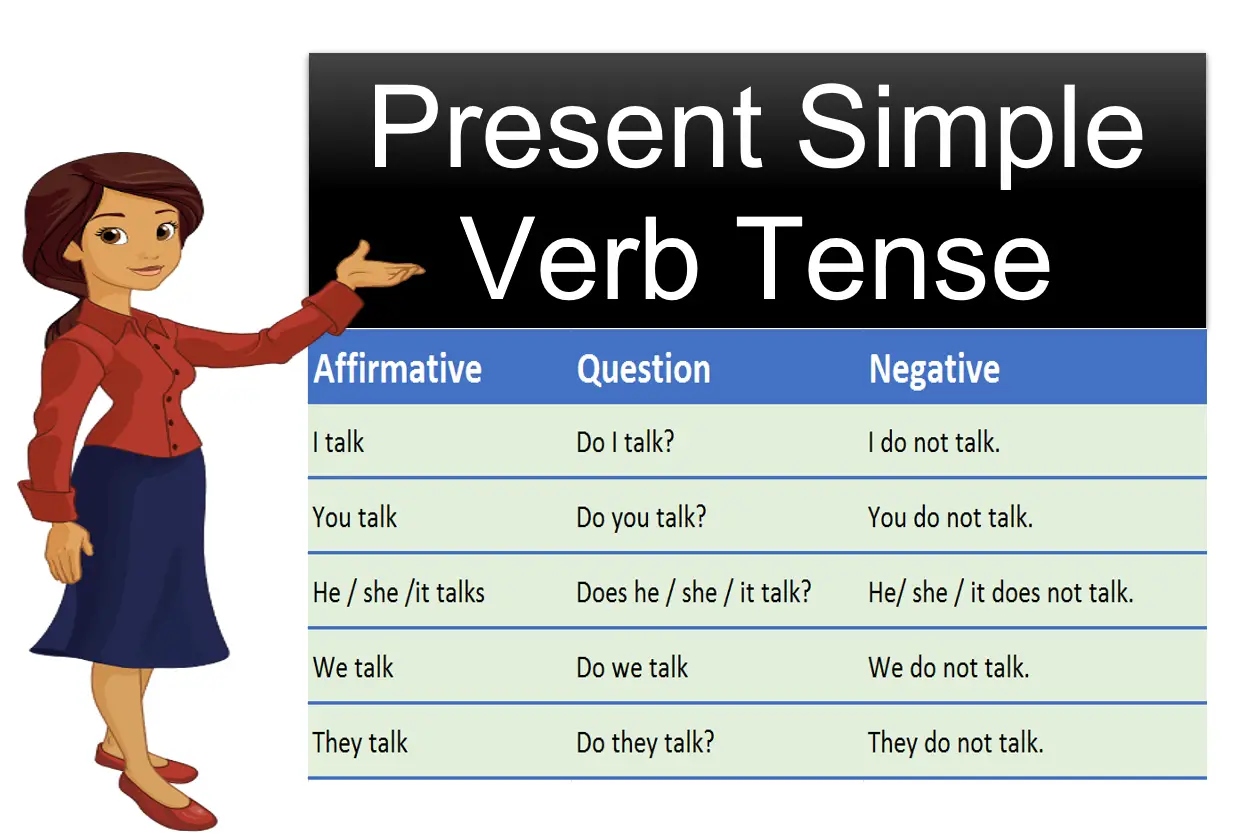Present Simple Verb Tense | Present simple English Forms of Verbs in Sentences
The Present Simple verb tense (also called the Simple Present) is very common in the English language, for it is used to talk activities that happen repeatedly and things that we do regularly such as habits and routines so it’s important to learn them. This time we will discuss about simple present tense verb in sentences and as a main verb and forms with examples.
Watch the video below of this full video tutorial.
This lesson will teach you how to form the present simple.
| Affirmative | Question | Negative |
| I talk | Do I talk? | I do not talk. |
| You talk | Do you talk? | You do not talk. |
| He / she /it talks | Does he / she / it talk? | He/ she / it does not talk. |
| We talk | Do we talk | We do not talk. |
| They talk | Do they talk? | They do not talk. |
Present simple – spelling of third person singular forms
Most verbs talk – talks
add -s to infinitives eat – eats
sleep -sleeps
Verbs ending in consonant + y, change y to i and add – es.
Present Simple Verb Tense Examples:
Fly – flies marry – marries
Try – tries hurry – hurries
Copy- copies cry – cries
Verbs ending in -s, -z, -sh, -ch or -x, add -es to infinitives.
wash – washes brush – brushes
relax – relaxes stress – stresses
touch – touches reach – reaches
guess – guesses mix – mixes
Exceptions:
Have – has
Go – goes
Do – does
Present simple verb tense forms and uses
Here are More discussion of the Simple Present Tense of Verbs.
- Facts or Permanent situations
Goats eat grass.
Goats are eating grass. X
My teacher arrives early.
Water boils at 100 Celsius. - To talk about activities that happen repeatedly and things that we do regularly, such as habits and routines.
I play badminton every Saturday.
They often travel to Thailand.
He gets up at 6:30 every day.
I don’t walk to school. - to talk about states or conditions, such as physical descriptions, feelings, relationships, knowledge, beliefs or possession.
She is tall and has long hair.
They like mangoes.
We want a new van.
I promise I will help you.
You look fantastic. - to describe situations that are more or less permanent. (If a situation is new or temporary, use the Present Continuous)
They work at a fire station.
I travel every summer.
She has two sons.
Where do you live?
He is single.
I‘m not Austrian, I‘m German. - The Present Simple is also used with the Zero conditional.
- We use the Present Simple to talk about what happens in books, movies, and plays.
A young man travels through Asia, where he meets different people, and finally falls in love.
In this book, the hero saves the princess and marries her.
The main character is gorgeous and works at a restaurant. - Future schedules, timetables, and fixed plans are expressed with the Present Simple, usually when they are set by an organization, not by us.
School begins at 8:30 and ends at 3:30.
The plane doesn’t arrive at 2:00, it arrives at 5:00.
When does the meeting start?
The train leaves every 20 minutes. - And finally, we also use it to talk about the future after words such as “when”, “until”, “before”, “after”, and “as soon as”.
He will call you when he has time. (Not ‘will have’)
I won’t go out until I finish my project.
I’ll give you the book before you leave.
I’m going to make breakfast after I take shower.
Downloadable Material
Here’s the downloadable material of Present Simple verb tense.
For more readings
- Modal Verb Could – Form, Use and Meaning in English
- To and Towards – Confusing English words | Vocabulary
- Conjunctions “And” “But” “Or” and “So”- English Lesson For Beginners
If you have any questions or suggestions about Present Simple Verb Tense, please feel free to leave a comment below or send us a message using our contact page.


